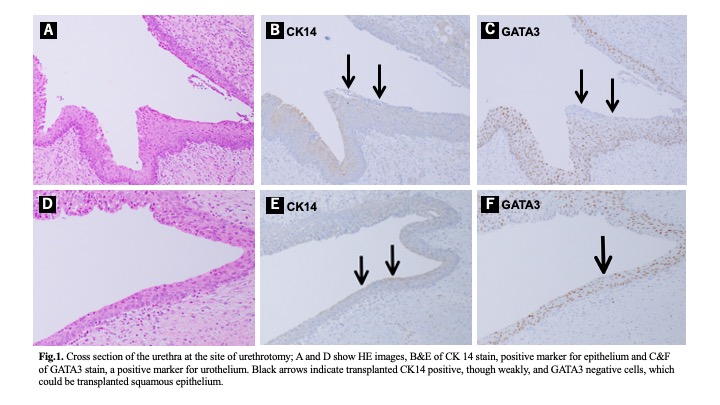Back
Poster, Podium & Video Sessions
Moderated Poster
MP22: Trauma/Reconstruction/Diversion: Urethral Reconstruction (including Stricture, Diverticulum) I
MP22-11: Successful Transurethral Engraftment of Buccal Mucosal Cells Expanded In Vitro, Transplanted in a Polymer Scaffold Carrier in a Rabbit Urethral Stricture Model, and Proven with Immunohistochemical Biomarkers
Saturday, May 14, 2022
8:45 AM – 10:00 AM
Location: Room 228
Akio Horiguchi*, Toshihiro Kushibiki, Kenichiro Ojima, Masayuki Shinchi, Yusuke Hirano, Yoshine Mayumi, Keiichi Ito, Kosuke Miyai, Saitama, Japan, Ichiro Miura, Hokkaido, Japan, Masayuki Takeda, Masaru Iwasaki, Yamanashi, Japan, Shojiro Kato, Senthilkumar Rajappa, Tokyo, Japan, Samuel JK Abraham, Yamanashi, Japan

Akio Horiguchi, MD, PhD
National Defense Medical COllege
Poster Presenter(s)
Introduction: Buccal mucosal (BM) cell therapies with different processing methods have been developed to treat male urethral stricture (US). Our earlier studies with six human subjects (DOI: 10.1111/iju.13852) and an animal model (DOI: 10.1016/j.reth.2021.05.004) confirmed the transurethral engraftment of autologous BM cells at urethral stricture sites when transplanted after encapsulation in a thermoreversible gelation polymer (TGP) scaffold. We report the reproducibility of the procedure in rabbit US models, proving engraftment with an immunohistochemical analysis.
Methods: The urethra of six male Japanese white rabbits were electro coagulated; US development was confirmed by endoscopy and urethrography 4 weeks later. The BM tissue was harvested, and its epithelial cells isolated and cultured for 7 days. After incising the US with a urethrotome, an 8 Fr-Nelaton catheter was placed in the urethra, and cultured epithelial cells suspended in TGP were injected into it. On the third day, the catheter was removed. On the seventh day after transplantation, the urethra was harvested and subjected to conventional hematoxylin and eosin (HE) staining and immunostaining with an anti-cytokeratin 14 (CK14) antibody (a marker for BM epithelial cells) and anti-GATA binding protein 3 (GATA3) antibody (a marker for urothelium).
Results: All animals developed US at the electrocoagulation site. HE staining showed that the urethral mucosal defect caused by the urethrotomy was covered with a multilayered squamous epithelium in all rabbits (Fig. 1A and D). The CK14 was positive on the lumen covered with a squamous epithelium (Fig. 1B and E). The GATA3 was negative in the region positive for CK14 while positively staining the remaining urothelium (Fig. 1C and F)).
Conclusions: Autologous BM cells with highly suggestive cell engraftment at the urethrotomy site based on immunohistochemical biomarkers are worth considering for a larger clinical study in male US.
Source of Funding: none

Methods: The urethra of six male Japanese white rabbits were electro coagulated; US development was confirmed by endoscopy and urethrography 4 weeks later. The BM tissue was harvested, and its epithelial cells isolated and cultured for 7 days. After incising the US with a urethrotome, an 8 Fr-Nelaton catheter was placed in the urethra, and cultured epithelial cells suspended in TGP were injected into it. On the third day, the catheter was removed. On the seventh day after transplantation, the urethra was harvested and subjected to conventional hematoxylin and eosin (HE) staining and immunostaining with an anti-cytokeratin 14 (CK14) antibody (a marker for BM epithelial cells) and anti-GATA binding protein 3 (GATA3) antibody (a marker for urothelium).
Results: All animals developed US at the electrocoagulation site. HE staining showed that the urethral mucosal defect caused by the urethrotomy was covered with a multilayered squamous epithelium in all rabbits (Fig. 1A and D). The CK14 was positive on the lumen covered with a squamous epithelium (Fig. 1B and E). The GATA3 was negative in the region positive for CK14 while positively staining the remaining urothelium (Fig. 1C and F)).
Conclusions: Autologous BM cells with highly suggestive cell engraftment at the urethrotomy site based on immunohistochemical biomarkers are worth considering for a larger clinical study in male US.
Source of Funding: none


.jpg)
.jpg)